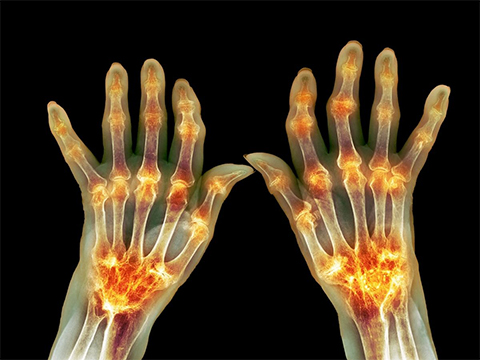RA patient blood reveals joint innerworkings
Many people ignore lingering joint pain, hoping it will fade, but persistent swelling could signal rheumatoid arthritis — a chronic autoimmune disease that not only attacks joints but also harms the lungs and kidneys.
In a recent study published in the journal Molecular & Cellular Proteomics, researchers at Leiden University Medical Center and Utrecht University used proteomics to show that proteins, including antibodies and autoantibodies, pass from blood into joint fluid without bias in RA patients.
Eva Maria Stork, a postdoctoral fellow at LUMC, Sofia Kalaidopoulou Nteak, a Ph.D. candidate at UU and Danique van Rijswijck, a faculty researcher at UU, used multilayer proteome analysis to provide evidence that RA therapeutics introduced into blood enter the synovial compartment at predictable ratios.

While swelling after an injury typically resolves, in RA it's an autoimmune response that causes persistent pain and long-term mobility issues.
Therapeutic treatments for RA include the systemic delivery of human monoclonal antibodies by injection into the bloodstream. Successful absorption of these treatments into SF; therefore, determines the efficacy of the therapy.
The procedure performed to draw synovial fluid out of a joint into a syringe for testing is called arthrocentesis. A large-gauge needle is inserted into the joint and the collected specimen is then transported to a laboratory for analysis.
“It’s more invasive, and it’s not the easiest thing for the patients,” Stork said.
Unlike earlier studies that measured the permeability of only a few proteins such as albumin and immunoglobulins, this study took a comprehensive, proteome-wide approach to investigate how molecules move between blood and joint fluid in RA. While previous reports suggested increased permeability, they didn’t analyze the full range of proteins or the autoantibody repertoire.
To address this, the researchers used data-independent acquisition liquid chromatography with tandem mass spectrometry, or LC–MS/MS, to identify and quantify hundreds of proteins. They paired this with total and antigen-specific Fab profiling to map both the general and RA-specific antibody responses across blood and synovial fluid.
Their workflow catalogued the entire RA proteome and mapped the diversity of IgG1 antibodies. It also compared autoantibody repertoires in plasma and synovial fluid.
“Previous studies usually picked individual proteins and looked at their concentrations on both sides,” Stork said. “We are now looking at a really high number of proteins and that gives us a more accurate way to conclude the correlation between (blood plasma and SF).”
LC–MS/MS analysis revealed 481 unique proteins across both plasma and SF in the RA patients.
Researchers determined that all detected plasma proteins, such as albumin and several plasma glycoproteins, were present in SF. Their abundance in plasma correlated with the abundance in SF of the same donor.
About 33% of proteins detected in SF represented plasma proteins. Proteins that were more abundant or solely detected in SF included cartilage proteins, cell nuclei and cellular cytoskeleton proteins and proteins originating in neutrophils.
“From our findings, those histones and cartilage proteins that we see in the synovial fluid are not found back in the plasma,” Kalaidopoulou said. “It really seems that (permeability) is one-way.”
Analysis of patients that received IgG1-based mAb therapy in the cohort revealed IgG1 Fab molecules were present in similar relative abundances between plasma and SF samples from the same patient.
Researchers concluded that plasma proteins enter SF from blood plasma in an unbiased manner, regardless of size, charge, concentration or other biochemical properties.
“It’s also important to make clear that what we see is only in rheumatoid arthritis patients,” van Rijswijck said. “I don’t think we would see this in healthy synovial fluid that’s not inflamed.”
These findings suggest that mAb therapy absorption could be determined via blood plasma analysis instead of invasive SF aspiration.
Stork believes that blood tests may become a patient-friendly method to determine therapeutic protein concentration in SF of RA patients in the future. Instead of obtaining SF through an invasive procedure, protein concentration could be determined through blood drawn for other medical checks.
LC–MS/MS for qualitative protein analysis is not possible in every hospital. However, Kalaidopoulou said that some hospitals are starting to use simple high-throughput liquid chromatographs for diagnostics. These machines would allow clinicians to analyze plasma proteins at the hospital rather than sending samples to third-party laboratories and paying for analyses.
“We are … at the direct interface of the hospital with the outpatient clinic,” Stork said. “Patients come in every day and are then directly connected with the lab. That’s what makes these studies feasible. We bring science to the needs of the patients.”
Enjoy reading ASBMB Today?
Become a member to receive the print edition four times a year and the digital edition monthly.
Learn moreGet the latest from ASBMB Today
Enter your email address, and we’ll send you a weekly email with recent articles, interviews and more.
Latest in Science
Science highlights or most popular articles

Exploring the link between lipids and longevity
Meng Wang will present her work on metabolism and aging at the ASBMB Annual Meeting, March 7-10, just outside of Washington, D.C.

Defining a ‘crucial gatekeeper’ of lipid metabolism
George Carman receives the Herbert Tabor Research Award at the ASBMB Annual Meeting, March 7–10, just outside of Washington, D.C.

The science of staying strong
Muscles power every movement, but they also tell the story of aging itself. Scientists are uncovering how strength fades, why some species resist it and what lifestyle and molecular clues could help preserve muscle health for life.

Bacteriophage protein could make queso fresco safer
Researchers characterized the structure and function of PlyP100, a bacteriophage protein that shows promise as a food-safe antimicrobial for preventing Listeria monocytogenes growth in fresh cheeses.

Building the blueprint to block HIV
Wesley Sundquist will present his work on the HIV capsid and revolutionary drug, Lenacapavir, at the ASBMB Annual Meeting, March 7–10, in Maryland.

Gut microbes hijack cancer pathway in high-fat diets
Researchers at the Feinstein Institutes for Medical Research found that a high-fat diet increases ammonia-producing bacteria in the gut microbiome of mice, which in turn disrupts TGF-β signaling and promotes colorectal cancer.

